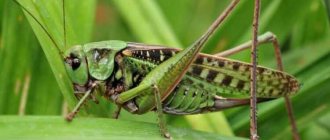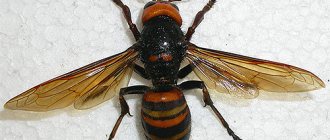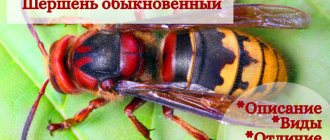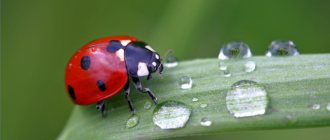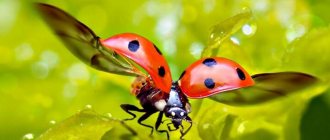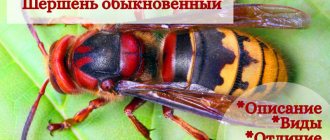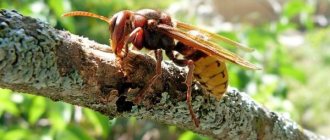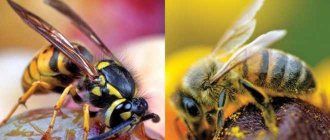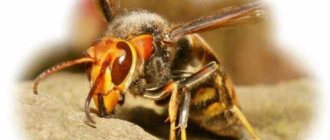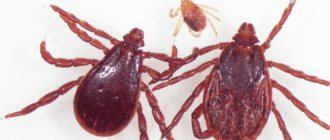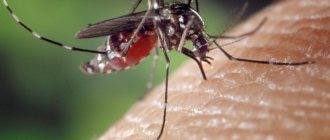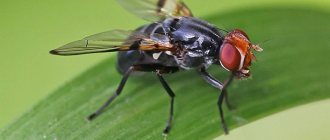Review author: “ZooVita”
The insect belongs to the class of wasps, but differs from them in body size. Hornets live in colonies, creating nests from a material that looks like paper. They obtain this building material themselves by grinding wood fibers with their jaws.
Today, scientists count about 20 species, each with its own differences and habitat.
Hornets collect material for construction from rotten stumps and birch branches.
0
The color of the building material is different from the color of materials of other members of the family, and the hornets’ nests look prettier, so to speak, not just a gray color, like ordinary wasps, but a real work of art, including color.
0
0
0
0
0
Wintering of insects
The peculiarity of hornets is that they lack thermoregulation. When cold weather sets in, they need to hide safely and fall into torpor. Otherwise, the insects die.
Making a nest for the winter
Insects build their homes from wood ground up by their jaws and mixed with saliva. To protect against temperature changes and other negative factors, the honeycombs themselves, in which the larvae develop, are wrapped in a wood mixture reminiscent of a paper cocoon.
The nest often resembles a pear or ball in shape. It is distinguished by amazing symmetry and precision of shape.
The larger the diameter of the wasp house, the more individuals live in it. The ability to build nests is passed on to each generation genetically. A fertilized female, the queen, wakes up after hibernation and chooses a place for the future residence of the entire swarm.
There she attaches the base and makes the first few (3-5) cells. Eggs are laid in them, the first larvae develop, from which worker representatives of the genus emerge. They also complete the construction of the hive afterwards. Nests are used only in the warm season for raising larvae in honeycombs.
Did you know? Home improvement work continues even in the dark.
Wasps settle in secluded places:
- hollows;
- animal burrows;
- under the roofs of houses;
- in the cracks of trunks;
- in rock crevices.
Wasps leave the house for the winter. Those individuals that are going to spend the winter do not specially prepare their hibernation site in any way. It is simply selected so that no one discovers the insect and accidentally destroys it. You should not be afraid that the wasp will decide to wait out the frosts in a warm human house.
Did you know? Insects can see in the dark and never sleep.
When and how do they hibernate?
In mid-autumn, the hornets leave the nest and begin active mating. With the arrival of frost, they cannot maintain their metabolism and in order to survive, they hibernate. Only fertilized female hornets settle down for the winter.
The queen, drones and workers simply die. The fluid in the insect's body is represented by glycerol. Thanks to this, it does not turn into a piece of ice at sub-zero temperatures and is able to warm up and continue to function with the arrival of spring.
Where do they spend the winter?
Females always settle down for the winter in a cold place. These can be unheated abandoned premises, recesses between bricks in the outer part of the walls of residential buildings, hollows, cracks in the bark, holes, places under large stones.
They nest in hollows, in attics, and in warm countries, nests are hung from tree branches.
0
0
0
0
What do they eat?
Nature created hornets as predators. Therefore, they mainly feed on other insects. They not only eat live insects, but can also feast on the carcass of a recently deceased animal. Hornets eat only those bodies in which the process of putrefaction has not yet begun. The diet of striped insects is supplemented by sweet fruits and berries, which are already beginning to decompose.
They love overripe fruits: plums, apricots, peaches, strawberries, raspberries, blackberries and grapes. With pleasure they feast on all beekeeping products. A squad of several hornets is capable of destroying an entire swarm of bees. They eat and take back to their nest everything they find in an empty hive. Thus, they can be safely classified as omnivores.
Hornet - photo
0
0
0
0
0
0
0
A couple of years ago we had a real boom - hornets were found literally at every step and in very large quantities. Especially in the evenings - crowds flew towards the light turned on in the garden. In subsequent years there were much fewer of them - and we again stopped noticing them. Have you ever had to deal with these insects? Share your experience in the comments!
Nutrition
Hornets feed mainly on rotting fruits, nectar, and in general any products that contain a sufficient amount of sugar or fructose. Hornets also like to include in their diet the sap of certain trees and various insects, such as wasps, bees, grasshoppers and the like. Having killed the victim with the help of their poison and processed it with powerful jaws, the hornets secrete a special suspension, which is used to feed the larvae.
Hornet collects nectar from a flower
Varieties
There are more than a dozen varieties of hornets, but only six of them are the most famous.
Ordinary
Distributed throughout Europe, except for its northern and extreme southern regions.
Black
Rare view. In European Union countries, hornets are under state protection; heavy fines are imposed for the destruction of their nests.
Giant Asian
It is dangerous for humans, as it releases a toxic substance when bitten.
Giant Japanese
The subspecies is endemic to the Japanese islands, where they can be found in forested areas of the country.
Oriental
The pigment xanthopterin in the light stripe of the insect's abdomen absorbs sunlight and converts it into electricity. Apparently for this reason, these hornets are more active on sunny days.
Philippine
The venom of this type of hornet is the most toxic among all existing wasps.
Population and species status
Photo: Hornet animal
The genus of hornets is quite wide. It includes more than twenty different species of insects, differing in color, size, feeding habits and lifestyle. Due to the presence of several species and high fertility, this genus is not endangered and is not listed in the Red Book.
The general population of hornets does not cause concern among scientists. It is normal, causes the least concern, and has a low risk of extinction. However, if we consider the hornet wasp population in terms of individual species, the situation is not so encouraging. Many species are on the verge of extinction and are listed in the Red Books of individual states and cities. The reduction in the number of such animals is due to completely different reasons, which can be found out in the next section of the publication.
The common hornet is an endangered species. Its population in different regions of its natural habitat is very unstable. In particular, this variety is included in the Red Book of the Smolensk region. Also a small representative of the hornet genus is the Dybovsky hornet (black). It is of average size for hornets, has a black-brown color, and is a predator. The black hornet is included in the Red Book of the Chita region. Some species of hornets are included in the Red Books of Germany and many other European countries.
Habitats
Hornets of various types can be found almost all over the planet, but a temperate climate is preferable for them. Therefore, they are mainly deployed in the northern hemisphere.
They can settle both in forests, large thickets and bushes, and near human habitation.
Varieties
There are more than a dozen varieties of hornets, but only six of them are the most famous.
Ordinary
Distributed throughout Europe, except for its northern and extreme southern regions.
Black
Rare view. In European Union countries, hornets are under state protection; heavy fines are imposed for the destruction of their nests.
Giant Asian
It is dangerous for humans, as it releases a toxic substance when bitten.
Giant Japanese
The subspecies is endemic to the Japanese islands, where they can be found in forested areas of the country.
Oriental
The pigment xanthopterin in the light stripe of the insect's abdomen absorbs sunlight and converts it into electricity. Apparently for this reason, these hornets are more active on sunny days.
Philippine
The venom of this type of hornet is the most toxic among all existing wasps.
Danger to humans
The hornet itself is not dangerous for humans, but if the latter shows aggression, the insect can secrete a special enzyme - a signal of fear, and a whole swarm will fly to the rescue.
Massive bites can lead to painful shock and even death. A single hornet sting is no more dangerous than a bee sting.
A hornet sting can also be dangerous due to an allergic reaction; untimely assistance can lead to anaphylactic shock and death.
Hornets themselves are not as dangerous to humans as is commonly thought, and severe consequences from their bites are often a reaction of the human body. The main condition when meeting hornets is not to show aggression towards them. If the insects decide that a person is attacking, the consequences can be dire.
People are afraid of hornets. And this fear is completely justified. When this large insect flies nearby, just its low, powerful buzzing makes your soul sink into your boots. It is also believed that if a hornet stings a person, such an attack can be fatal for the latter. Are hornets as dangerous as people think, what and how do they live? Appearance […]
—>
Habitats
Hornets of various types can be found almost all over the planet, but a temperate climate is preferable for them. Therefore, they are mainly deployed in the northern hemisphere.
They can settle both in forests, large thickets and bushes, and near human habitation.
Reproduction
When weather conditions change - the sun's rays warm up - females begin to actively search for a place to lay eggs. Representatives fly over large areas to find the best shelter for the future creation of a family. When a convenient corner is found, the construction of the hive begins immediately.
Each egg is supposed to have its own sector. After a few days, small individuals hatch from them and chew the roof. Long before the start of the winter period, the female hatches offspring, which will continue the work of the uterus.
After the fertilization process, the male dies, after which the old queen also dies. After another period of time, individuals that have not undergone fertilization die. Fertilized representatives of the colony spend the winter, after which they begin to create a new nest.
Only a well-coordinated family organizational system allows insects to reproduce successfully. And thanks to the division of responsibilities between females, males and the uterus, there is a harmonious system of feeding, building and raising offspring.
